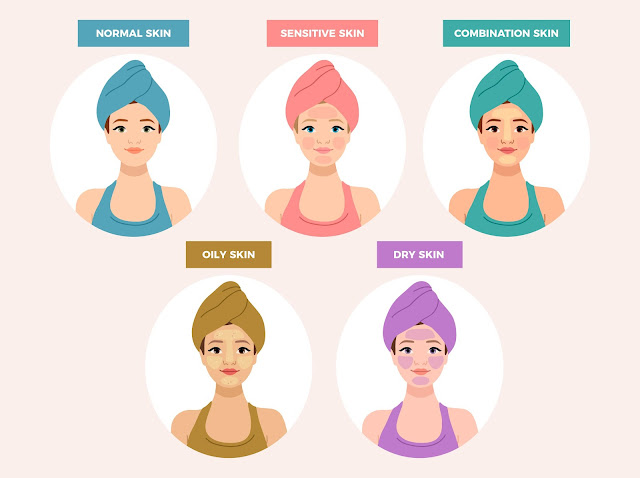5 Different Skin Types: Which Skin Type Do I Have?
Your skin is your body's largest organ and plays a crucial role in both protecting you from the outside world and revealing your overall health. To keep your skin in its best condition, you need to understand your skin type and how to care for it. In this comprehensive guide, we'll explore the five most common skin types and provide practical tips for achieving healthy, radiant skin.
1. Normal Skin
Normal skin is often the gold standard when it comes to skin types. It's characterized by balanced moisture levels, small pores, and few imperfections. If you're blessed with normal skin, you're less likely to experience acne breakouts or dry patches.
How to Care for Normal Skin
- Cleansing: Start with a gentle cleanser to remove dirt and impurities.
- Moisturizing: Use a lightweight, hydrating moisturizer to maintain your skin's natural balance.
- Sun Protection: Don't forget sunscreen to protect against UV damage.
Product Recommendations for Normal Skin
- A mild, sulfate-free cleanser.
- A non-comedogenic, hydrating moisturizer.
- A broad-spectrum SPF 30 or higher sunscreen.
2. Oily Skin
Oily skin is the result of overactive sebaceous glands, leading to an excess of oil production. This can result in enlarged pores and an increased tendency for acne. If you have oily skin, you may be familiar with that afternoon shine.
How to Care for Oily Skin
- Cleansing: Use a gentle, oil-free cleanser to prevent over-drying.
- Exfoliation: Incorporate exfoliating products with salicylic acid to keep pores clear.
- Moisturizing: Opt for a lightweight, oil-free moisturizer.
- Sunscreen: Use a non-comedogenic, matte-finish sunscreen.
Product Recommendations for Oily Skin
- A foaming, salicylic acid cleanser.
- An oil-free, hydrating gel moisturizer.
- A sunscreen with oil control properties.
3. Dry Skin
Dry skin often feels tight, flaky, and may be prone to sensitivity. If you have dry skin, you know the struggle of trying to keep it moisturized and comfortable.
How to Care for Dry Skin
- Gentle Cleansing: Use a hydrating, sulfate-free cleanser.
- Hydrating: Invest in a rich, emollient moisturizer to lock in moisture.
- Protect the Skin Barrier: Look for products with ceramides to strengthen the skin's barrier.
- Sunscreen: Use a moisturizing sunscreen to prevent further dryness.
Product Recommendations for Dry Skin
- A creamy, hydrating cleanser.
- A rich, fragrance-free moisturizer with hyaluronic acid.
- A sunscreen with added moisturizing ingredients.
4. Combination Skin
Combination skin can be a bit of a puzzle, with different areas of the face having different characteristics. For instance, you may have an oily T-zone but dry cheeks.
How to Care for Combination Skin
- Addressing Both Dry and Oily Areas: Use a gentle cleanser for the entire face, but apply moisturizer according to the specific needs of each area.
Product Recommendations for Combination Skin
- Customize your routine with products suitable for both oily and dry areas.
5. Sensitive Skin
Sensitive skin is easily irritated, often displaying redness and itching. It can be challenging to find products that won't cause discomfort.
How to Care for Sensitive Skin
Fragrance-Free Products: Avoid products with added fragrances, as they can trigger irritation.
Patch Testing: Always test new products on a small area to check for adverse reactions.
Sun Protection: Protect your sensitive skin from UV damage with a gentle sunscreen.
Product Recommendations for Sensitive Skin
- A fragrance-free, gentle cleanser.
- A hypoallergenic, soothing moisturizer.
- A broad-spectrum, mineral sunscreen for sensitive skin.
Other Types of Skin
1. Scaly Skin
Scaly skin can be uncomfortable and unsightly. It often presents as dry, flaky patches that may be itchy or even painful. This condition can occur due to various factors, including environmental factors, genetics, or underlying health issues.
How to Care for Scaly Skin
- Hydration: Keep your skin well-hydrated by drinking plenty of water and using a thick, emollient moisturizer.
- Gentle Exfoliation: Exfoliate scaly areas gently to remove dead skin cells, but avoid overdoing it, as it can exacerbate the problem.
- Humidifiers: Consider using a humidifier in your home to maintain proper indoor humidity levels.
2. Red Spots
Red spots on the skin can be caused by various factors, including allergies, irritation, skin conditions, or even insect bites. Identifying the cause is essential for proper treatment.
How to Care for Red Spots
- Identify the Cause: If you notice red spots, try to determine the underlying cause. Allergies, skin conditions, or insect bites all require different approaches.
- Topical Creams: Depending on the cause, topical creams with anti-inflammatory properties or antihistamines may help alleviate redness and itching.
- Seek Medical Advice: If red spots persist or are accompanied by other concerning symptoms, consult a dermatologist for a proper diagnosis and treatment plan.
3. Skin Moles
Moles are common, benign growths on the skin. While most moles are harmless, it's crucial to keep an eye on them for any changes, as certain moles may pose a risk of skin cancer.
How to Care for Skin Moles
- Regular Self-Examinations: Perform regular self-examinations to monitor your moles. Pay attention to any changes in size, color, shape, or texture.
- Sun Protection: Protect your moles from UV radiation by applying sunscreen and wearing protective clothing.
- Consult a Dermatologist: If you notice any concerning changes in a mole or have a mole that looks unusual from the start, consult a dermatologist for a professional evaluation.
Conclusion
Understanding and caring for your skin type is essential, but it's equally important to be aware of common skin conditions and issues that can affect anyone. Whether you're dealing with scaly skin, red spots, or keeping an eye on your moles, the key is vigilance and proper care. By staying informed and taking action when needed, you can maintain healthy, radiant skin that makes you feel confident and comfortable in your own skin.






